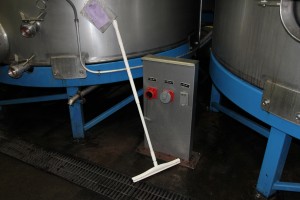We?re over a month into Harvest and grapes are still coming fast and furious into the winery.? In fact, 2012 is turning out to be one of the largest crops in years, thanks to a summer of great weather. In a normal year we use a lot of energy and water to pick, crush and ferment our grapes, and this year is no different.
Imagine it is 90 degrees outside and you and everything around you are covered in sticky, sweet grape juice.? Then imagine that happens every day for two months. It can be tempting to grab a hose and wash everything down or into the catchment basin.
But doing that uses a lot of water. Just because it?s Harvest doesn?t mean it?s a good reason to forget about sustainability. There are a lot of different ways to stay clean (and not sticky) during this time of the year that are efficient and reduce our overall energy and water use.
 One of the best ways to start is with a broom. We sweep up grape skins and push them into the lift that carries them to a dump truck that goes to the compost facility.? Pushing grape skins with a hose uses a lot of water — a broom uses none.
One of the best ways to start is with a broom. We sweep up grape skins and push them into the lift that carries them to a dump truck that goes to the compost facility.? Pushing grape skins with a hose uses a lot of water — a broom uses none.
Next, we use hoses with high-pressure nozzles (like a power sprayer) to dissolve sugar and wash it into drains that lead to water treatment ponds. There?s no way around using water here because we have to dissolve the sugar. However, the high-pressure hoses use only about 25% the water per minute of a regular hose nozzle. That small change lets us save quite a bit of water and energy.
The second largest consumer of energy is our chiller system.? After the grapes are pressed the juice has to be kept cool during the fermentation process.? Over the past few years we have invested in our chilling system, installing new motors and pumps, to increase efficiency. Harvest is the time for these upgrades to shine. ?Our upgrades are now saving thousands of kilowatt hours (kWh).

Grapes skins after being crushed.
I think the most innovative part of sustainability during Harvest comes from our new experiments with using the grape skins and seeds to make flour and oil. We?ve partnered with Whole Vine to turn the grape skins into flour, which is naturally gluten free. Whole Vine is then using that flour to make cookies.
I particularly like the Cabernet flour cookies.? It?s a step beyond composting ? instead of breaking down the skins into nutrients, we are turning them into high-quality foods.? It makes sense: after putting so much effort into producing amazing grapes that we would want to enjoy them as many ways as possible.
Get ready for the 2012 vintage ? and the cookies it?ll eventually make — because it?s going to be one of our most delicious and most sustainable yet.

